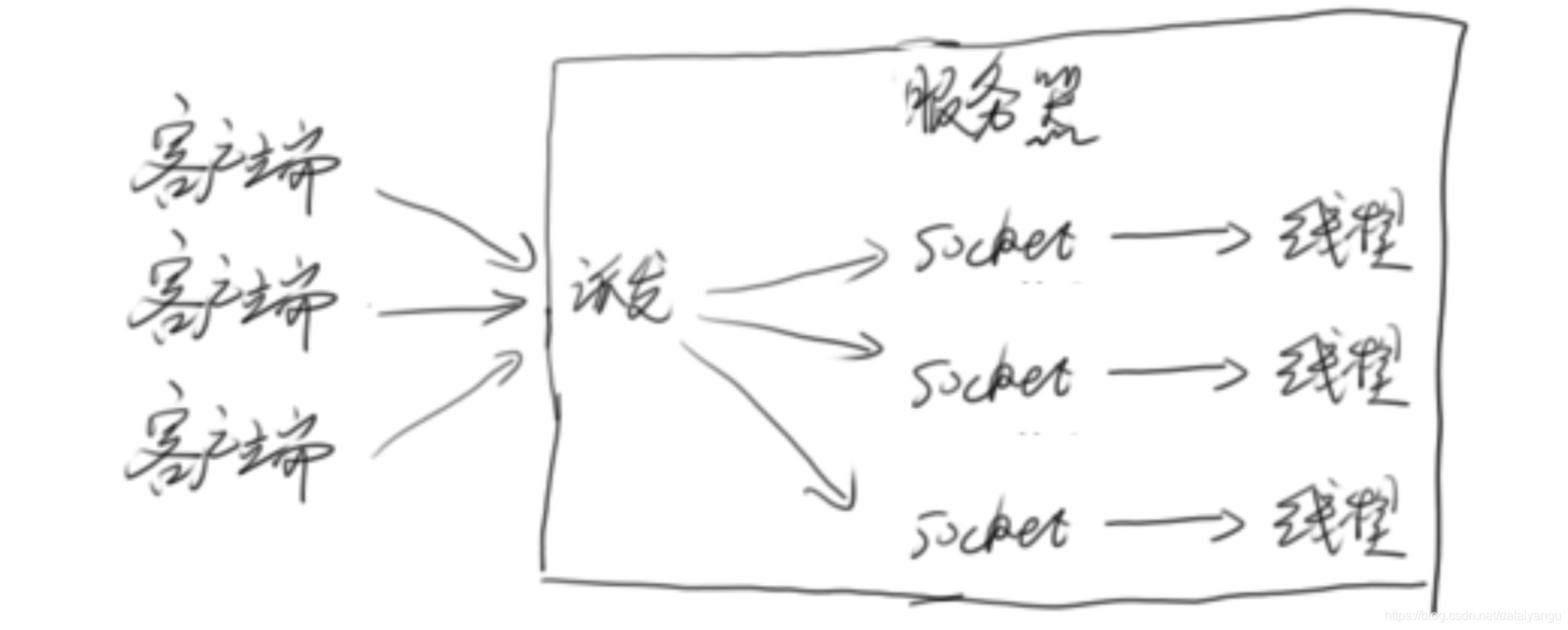文章目录
什么是NIO
NIO是New I/O的简称,与旧式的基于流的I/O方法相对,从名字看,它表示新的一套Java I/O标 准。它是在Java 1.4中被纳入到JDK中的,并具有以下特性:
– NIO是基于块(Block,硬盘上的块)的,它以块为基本单位处理数据,传统的是基于字节的,最小单位是字节,NIO最小单位是块。
– 为所有的原始类型提供(Buffer)缓存支持
– 增加通道(Channel)对象,作为新的原始 I/O 抽象
– 支持锁和内存映射文件的文件访问接口,拿文件系统来实现锁,就是我们平常的.log文件。
– 提供了基于Selector的异步网络I/O
Buffer && Channel

文件的读写都是通过Buffer读写到Channel,然后再到文件。Channel左边就是对应的我们的文件。
Buffer
每个基本类型都有对应的buffer
Object
-Buffer
-ByteBuffer
-CharBuffer
-DoubleBuffer
-FloatBUffer
-IntBuffer
-LongBuffer
-ShortBuffer
举个栗子
FileInputStream fin = new FileInputStream(new File("d:\\temp_buffer.tmp"));
//通过InputStream得到channel。
FileChannel fc=fin.getChannel();
//通过ByteBuffer分配1k的大小的buffer
ByteBuffer byteBuffer=ByteBuffer.allocate(1024);
//通过channel将1k大小的数据读到buffer中
fc.read(byteBuffer);
fc.close();
//对buffer中的数据进行读写转换,后面可能要对buffer中的数据进行读取。
byteBuffer.flip();
NIO复制文件
public static void nioCopyFile(String resource, String destination) throws IOException {
FileInputStream fis = new FileInputStream(resource);
FileOutputStream fos = new FileOutputStream(destination);
FileChannel readChannel = fis.getChannel();//读文件通道
FileChannel writeChannel = fos.getChannel();//写文件通道
ByteBuffer buffer = ByteBuffer.allocate(1024); //读入数据缓存
while (true) {
buffer.clear();
int len = readChannel.read(buffer); //读入数据
//len读到数据的大小
if (len == -1) {
break;
//读取完毕
}
buffer.flip();
writeChannel.write(buffer);
//写入文件
}
readChannel.close();
writeChannel.close();
}
Buffer中有3个重要的参数:
位置(position)、容量(capactiy)和上限(limit)
| 参数 | 写模式 | 读模式 |
|---|---|---|
| 位置 | 当前缓冲区的位置,将从position的下一个位置写数据 | 当前缓冲区读取的位置,将从此位置后,读取数据 |
| 容量 | 缓存区的总容量上限 | 缓存区的总容量上限 |
| 上限 | 缓冲区的实际上线,他总是小于等于容量。通常情况下和容量相等 | 代表刻度的总容量,和上次写入的数据量相等 |
代码展示
ByteBuffer b=ByteBuffer.allocate(15); //15个字节大小的缓冲区
System.out.println("limit="+b.limit()+" capacity="+b.capacity()+" position="+b.position());
for(int i=0;i<10;i++){ //存入10个字节数据
b.put((byte)i);
}
System.out.println("limit="+b.limit()+" capacity="+b.capacity()+" position="+b.position());
b.flip(); //重置position
System.out.println("limit="+b.limit()+" capacity="+b.capacity()+" position="+b.position());
for(int i=0;i<5;i++){
System.out.print(b.get());
}
System.out.println();
System.out.println("limit="+b.limit()+" capacity="+b.capacity()+" position="+b.position()); b.flip();
System.out.println("limit="+b.limit()+" capacity="+b.capacity()+" position="+b.position());
图解
新建

存入10byte

flip

该操作会重置position,通常,将buffer从写模式转换为读 模式时需要执行此方法 flip()操作不仅重置了当前的position为0,还将limit设置到当 前position的位置
五次读操作

flip


几个重要的函数
public final Buffer rewind()
– 将position置零,并清除标志位(mark)
public final Buffer clear()
– 将position置零,同时将limit设置为capacity的大小,并清除了标志mark
public final Buffer flip()
– 先将limit设置到position所在位置,然后将position置零,并清除标志位mark – 通常在读写转换时使用
文件映射到内存
RandomAccessFile raf = new RandomAccessFile("C:\\mapfile.txt", "rw");
FileChannel fc = raf.getChannel();
//将文件映射到内存中
MappedByteBuffer mbb = fc.map(FileChannel.MapMode.READ_WRITE, 0, raf.length());
while(mbb.hasRemaining()){
System.out.print((char)mbb.get());
}
mbb.put(0,(byte)98); //修改文件
raf.close();
网络编程
多线程网络服务器的一般结构

简单案例 EchoServer
EchoServer
public static void main(String args[]) {
ServerSocket echoServer = null;
Socket clientSocket = null;
try {
echoServer = new ServerSocket(8000);
} catch (IOException e) {
System.out.println(e); }
while (true) {
try {
clientSocket = echoServer.accept(); System.out.println(clientSocket.getRemoteSocketAddress() + " connect!");
tp.execute(new HandleMsg(clientSocket));
} catch (IOException e) {
System.out.println(e); }
}
}
主线程在这里制作一个接收accept的功能。
HandleMsg
static class HandleMsg implements Runnable{
//省略部分信息
public void run(){
try {
is = new BufferedReader(new InputStreamReader(clientSocket.getInputStream()));
os = new PrintWriter(clientSocket.getOutputStream(), true);
// 从InputStream当中读取客户端所发送的数据
String inputLine = null;
long b=System.currentTimeMillis();
while ((inputLine = is.readLine()) != null) {
os.println(inputLine);
}
long e=System.currentTimeMillis();
System.out.println("spend:"+(e-b)+"ms");
} catch (IOException e) {
e.printStackTrace(); }finally{
//关闭资源
}
}
读到什么就回写什么
EchoServer的客户端
public static void main(String[] args) throws IOException {
Socket client = null;
PrintWriter writer = null;
BufferedReader reader = null;
try {
client = new Socket();
client.connect(new InetSocketAddress("localhost", 8000)); writer = new PrintWriter(client.getOutputStream(), true); writer.println("Hello!");
writer.flush();
reader = new BufferedReader(new InputStreamReader(client.getInputStream()));
System.out.println("from server: " + reader.readLine());
} catch{
} finally {
//省略资源关闭
}
}
问题:
– 为每一个客户端使用一个线程,如果客户端出现延时等异常,线程可能会被占用很长时间。因为数据的准备和读取都在这个线程中。
– 此时,如果客户端数量众多,可能会消耗大量的系统资源
解决
– 非阻塞的NIO
– 数据准备好了在工作
注意:io真正的工作分为准备和读取两个部分。nio就是在准备玩了之后才会分配读取的操作。
模拟低效的客户端
private static ExecutorService tp=Executors.newCachedThreadPool(); private static final int sleep_time=1000*1000*1000;
public static class EchoClient implements Runnable{
public void run(){
try {
client = new Socket();
client.connect(new InetSocketAddress("localhost", 8000));
writer = new PrintWriter(client.getOutputStream(), true); writer.print("H");
LockSupport.parkNanos(sleep_time);
writer.print("e");
LockSupport.parkNanos(sleep_time);
writer.print("l");
LockSupport.parkNanos(sleep_time);
writer.print("l");
LockSupport.parkNanos(sleep_time);
writer.print("o");
LockSupport.parkNanos(sleep_time);
writer.print("!");
LockSupport.parkNanos(sleep_time);
writer.println();
writer.flush();
服务器输出
spend:6000ms
spend:6000ms
spend:6000ms
spend:6001ms
spend:6002ms
spend:6002ms
spend:6002ms
spend:6002ms
spend:6003ms
spend:6003ms
这里的6秒花在了哪里?
注意上面的代码块
long b=System.currentTimeMillis();
while ((inputLine = is.readLine()) != null) {
os.println(inputLine);
}
long e=System.currentTimeMillis();
System.out.println("spend:"+(e-b)+"ms");
读和写一共花了六秒,读的时候花了很多时间读不到
网络编程NIO

把数据准备好了再通知我 Channel有点类似于流,一个Channel可以和文件或者网络Socket对应
Selector:多路复用选择器 Selector,它是NIO编程的基础,非常重要,多路复用器提供选择已经就绪的任务的能力。简单说,就是Selector会不断地轮询注册在其上的通道(Channel) 假如某个通道发生了读写操作,这个通道就处于就绪状态,会被Selector轮询出来,然后通过SelectionKey可以取得就绪的Channel集合,从而进行后续的IO操作。一个Selector可以负责成千上万Channel通道,没有上线,这也是JDK使用了epoll代替了传统的select实现,获得连接句柄没有限制。这就意味着 我们只需要一个线程负责Selector的轮询,就可以接入成千上万个客户端。
Selector准备好数据后,返回SelectionKey SelectionKey表示一对Selector和Channel的关系, 从SelectionKey中可以得到Channnel(数据已经准备), 并读取数据
select()和selectNow():
select方法如果没有一个channel准备好数据的话,就会出现阻塞,selectNow不论有没有准备好,都会有一个返回值,不会出现阻塞。
参考代码
import java.io.IOException;
import java.net.InetAddress;
import java.net.InetSocketAddress;
import java.nio.ByteBuffer;
import java.nio.channels.*;
import java.nio.channels.spi.SelectorProvider;
import java.util.Iterator;
import java.util.LinkedList;
import java.util.Set;
public class NioTest {
private void StartServer ()throws Exception{
final Selector selector = SelectorProvider.provider().openSelector();
ServerSocketChannel ssc = ServerSocketChannel.open();
//将ServerSocketChannel设置为非阻塞的,accept不会一直等待,即数据准备好了,给个通知。
ssc.configureBlocking(false);
InetSocketAddress isa = new InetSocketAddress(8000);
ssc.socket().bind(isa);
//给channel注册一个感兴趣的事件,即accept事件,如果有人accept,selector就告诉ssc
SelectionKey acceptKey = ssc.register(selector, SelectionKey.OP_ACCEPT);
for (; ; ) {
//已经有数据准备好了(读、写、accept)
selector.select();
// if (selector.selectNow() == 0) {
// continue;
// }
Set readyKeys = selector.selectedKeys();
Iterator i = readyKeys.iterator();
long e = 0;
while (i.hasNext()) {
SelectionKey sk = (SelectionKey) i.next();
//remove掉,是为了防止后面重复处理。
i.remove();
//如果是一个accept的事件
if (sk.isAcceptable()) {
doAccept(sk);
}
//如果是一个读的事件,读已经准备好了
else if(sk.isValid()&&sk.isReadable()){
// 将时间做一个记录
if (!geym_time_stat.containsKey(((SocketChannel) sk.channel()).socket())) {
geym_time_stat.put(((SocketChannel) sk.channel()).socket(),System.currentTimeMillis() );
doRead(sk);
}
}
//如果是一个写的事件
else if (sk.isValid() && sk.isWritable()) {
doWrite(sk);
e = System.currentTimeMillis();
//耗时的统计
long b = geym_time_stat.remove(((SocketChannel) sk.channel()).socket());
System.out.println("spend:"+(e-b)+"ms");
}
}
}
class HandleMsg implements Runnable{
SelectionKey sk;
ByteBuffer bb;
public HandleMsg(SelectionKey sk,ByteBuffer bb){
this.sk= sk;
this.bb = bb;
}
public void run() {
// 将之前添加的附件拿出来
EchoClient echoClient = (EchoClient) sk.attachment();
echoClient.enqueue(bb);
// 将SelectionKey感兴趣的事件修改为OP_READ和OP_WRITE;
sk.interestOps(SelectionKey.OP_READ | SelectionKey.OP_WRITE);
// 强迫Selector立即返回
selector.wakeup();
}
}
}
private void doRead(SelectionKey sk){
SocketChannel channel = (SocketChannel) sk.channel();
ByteBuffer bb = ByteBuffer.allocate(8192);
int len;
try{
len = channel.read(bb);
if (len < 0) {
disconnect(sk);
return;
}
} catch (IOException e) {
System.out.println("Field to read from client");
e.printStackTrace();
disconnect(sk);
return;
}
bb.flip();
tp.excute(new HandleMsg(sk, bb));
}
private void doWrite(SelectionKey sk){
SelectableChannel channel = sk.channel();
EchoClient echoClient = (EchoClient) sk.attachment();
LinkedList<ByteBuffer> outq = echoClient.getOutputQueue();
ByteBuffer bb = outq.getLast();
try {
// 回写到channel中
int len = channel.write(bb);
if (len == -1) {
disconnect(sk);
return;
}
if (bb.remaining() == 0) {
outq.removeLast();
}
} catch (Exception e) {
System.out.println("Faild to write to client .");
e.printStackTrace();
disconnect(sk);
}
//队列中的数据已经回写完毕的话
if (outq.size() == 0) {
// 将对写事件感兴趣去掉。
sk.interestOps(SelectionKey.OP_READ);
}
}
private void doAccept(SelectionKey sk){
ServerSocketChannel server = (ServerSocketChannel) sk.channel();
SocketChannel clientChannel;
try {
clientChannel = server.accept();
clientChannel.configureBlocking(false);
//希望能读数据
SelectionKey clientKey = clientChannel.register(selector, SelectionKey.OP_READ);
EchoClient echoClient = new EchoClient();
// 增加一个附件给Key
clientKey.attach(echoClient);
InetAddress clientAddress = clientChannel.socket().getInetAddress();
System.out.println("Accepted connection from "+clientAddress.getHostAddress());
} catch (Exception e) {
System.out.println("Faild to accept new client");
e.printStackTrace();
}
}
class EchoClient{
LinkedList<ByteBuffer> outq;
EchoClient(){
outq = new LinkedList<ByteBuffer>();
}
// 读到数据就往里面塞
public void enqueue(ByteBuffer bb){
outq.addFirst(bb);
}
}
}
以上是通过nio的方式实现上面的功能,从6s多变为了几毫秒,因为只是部分代码,所以没有运行结果。
总结:
– NIO会将数据准备好后,再交由应用进行处理,数据如果没有准备好,是不会进入到应用中的,数据的读取过程依然在应用线程中完成 ,等待的时间剥离到一个独立的线程中去等待(selector.select();)。
– 节省数据准备时间(因为Selector可以复用)
AIO
异步io
上面的NIO只是将等待的时间剥离到少数的线程中,避免大量的线程等待,造成的资源浪费,AIO等你写完了或者读完了再通知我。不需要读,也不需要写,只需要等系统把数据都处理完了之后,把回调函数放进去,就会执行,AIO不会加快io,io本身的速度并没有加快,只是改变了原来的线程对io的处理方式,看起来是变快了。
特点总结:
读完了再通知我
不会加快IO,只是在读完后进行通知
使用回调函数,进行业务处理
基本思想
用到的类
AsynchronousServerSocketChannel
server = AsynchronousServerSocketChannel.open().bind(new InetSocketAddress(PORT));
使用server上的accept方法
public abstract <A> void accept(A attachment,
CompletionHandler<AsynchronousSocketChannel,? super A>handler);
因为AIO是异步的,将accept调用了之后立即返回,但是并没有真正拿到客户端的数据,CompletionHandler<AsynchronousSocketChannel,? super A>handler这个接口的作用就是在真正accept的时候,将accept得到的数据传给handler,供后面的相关操作使用。
其他的方法
AsynchronousSocketChannel
因为是异步的,肯定不能读完了之后再返回,所以所有的方法都是立即返回的
– read

TimeUnit是超时时间
第三个函数只有一个参数,但是会返回一个future,告知读到了第几个字节
第四个函数是读到了ByteBuffer数组中,因为网络报文的前二十(举例)个字节是无用的,直接剥离掉,能直接拿到有用的数据。
– write

代码实现
server.accept(null, new CompletionHandler<AsynchronousSocketChannel, Object>() {
final ByteBuffer buffer = ByteBuffer.allocate(1024);
网络编程 AIO
public void completed(AsynchronousSocketChannel result, Object attachment) {
System.out.println(Thread.currentThread().getName()); Future<Integer> writeResult=null;
try {
buffer.clear();
result.read(buffer).get(100, TimeUnit.SECONDS);
buffer.flip();
writeResult=result.write(buffer);
} catch (InterruptedException | ExecutionException e) { e.printStackTrace();
} catch (TimeoutException e) { e.printStackTrace();
} finally { try {
//执行完了之后再次执行accept,防止执行完了没事干了。
server.accept(null, this);
writeResult.get();
result.close();
} catch (Exception e) {
System.out.println(e.toString()); }
}
}
@Override
public void failed(Throwable exc, Object attachment) {
System.out.println("failed: " + exc);
}
});
上面是accept的代码实现,